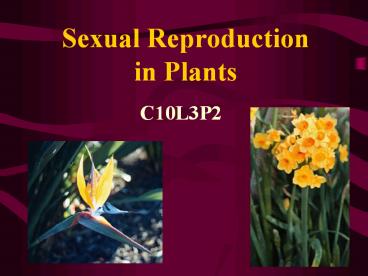Sexual%20Reproduction%20in%20Plants - PowerPoint PPT Presentation
Title:
Sexual%20Reproduction%20in%20Plants
Description:
Sexual Reproduction in Plants C10L3P2 monoecious plant any plants on which staminate and pistillate flowers are produced (oaks, walnuts, hickories, birches) dioecious ... – PowerPoint PPT presentation
Number of Views:209
Avg rating:3.0/5.0
Title: Sexual%20Reproduction%20in%20Plants
1
Sexual Reproduction in Plants
- C10L3P2
2
Genesis 111-13 11 Then God said, "Let the earth
bring forth grass, the herb that yields seed, and
the fruit tree that yields fruit according to its
kind, whose seed is in itself, on the earth" and
it was so. 12 And the earth brought forth
grass, the herb that yields seed according to its
kind, and the tree that yields fruit, whose seed
is in itself according to its kind. And God saw
that it was good. 13 So the evening and the
morning were the third day.
3
Review
- genetic variety
- gene pairs
- Diploid
- Haploid
- gametes
4
In plants gametes are produced in flowers, cones,
or other special structures.
5
Flowers have one primary function for the plant
to produce seeds for reproduction.
6
A flowers color, shape, and smell is designed by
God to help carry out the flowers reproductive
processes.
7
Flowers
A typical flower consists of 4 different types of
appendages sepals, petals, stamens, carpels
(pistils).
8
Arrangement of flower parts
There may be few or many of each of the four
types, but each type usually is positioned on the
flower base in the same relative location.
- sepals outermost
- petals inside sepals
- stamens inside petals
- carpels in the center
9
pedicel
the flower stalk supports the flower
10
receptacle
the end of the pedicel that bears the floral
parts and holds the developing seeds
receptacle
11
sepal
the leaflike outermost structure of a flower
usually green (some exceptions like the tulip
the tulips sepals are the same color and size as
its petals
sepal
12
sepal
(collectively called the calyx) protects the
other floral parts as they develop in the bud
13
petal
any of the brightly colored leaflike structures
(often the largest and most colorful parts)
14
petal
(collectively called the corolla) they attract
insects and animals with their showy colors and
sweet nectar
15
stamen
the male reproductive part of a flower the organ
which produces pollen (contains sperm)
16
Two parts of the stamen
- Filament
- Anther
17
filament
slender, elongated stalk bears the anther
18
anther
the enlarged structure at the tip of the stamen
(knobby sac) produces the pollen
19
pollen
each kind of pollen has a definite shape and
surface texture many are covered with spikes or
knobs
20
Carpels (pistil)
elongated, vase-shaped female reproductive part
of a flower the central structure in a flower
21
Parts of the Carpel
- Stigma
- Style
- Ovary
22
stigma
the tip of the pistil that receives pollen (often
sticky)
23
style
the stalklike structure of the pistil
24
ovary
the swollen base of the pistil that contains the
future seeds
25
ovary
The ovary may be superior (above the receptacle)
or inferior (within the receptacle)
26
ovules
the future seeds (contain ova)
27
complete flower
one which has sepals, petals, stamens, and pistils
28
incomplete flower
lacks one or more of the four basic flower parts
29
incomplete flower
example poinsetta - they lack petals the
bright red structures are special leaves called
bracts all of the plants of the grass family
produce incomplete flowers that have bracts
instead of petals and sepals.
30
incomplete flower
Specific terms are applied to incomplete flowers
that lack either stamens or pistils
- staminate
- pistillate
31
staminate
lack pistils and have stamens (male flowers)
32
pistillate
lack stamens and have pistils (female flowers)
33
Incomplete flower example
In Corn the tassels are staminate flowers the
ears are pistillate flowers
34
monoecious plant
any plants on which staminate and pistillate
flowers are produced (oaks, walnuts, hickories,
birches)
35
dioecious plant
produce staminate flowers on one plant and
pistillate flowers on another (willows, poplars,
American holly)
36
pollination
the transfer of pollen from an anther to the
stigma
37
types of pollination
self-pollination occurs in the same flower or
with another flower of the same
plant cross-pollination from the anther of one
plant to the stigma of a flower on another plant
38
Self-pollination
39
Cross-pollination
40
after pollination
the fertilized ovum is a zygote that grows into a
tiny embryo plant the ovule develops into a seed
(The seed contains the embryo, some stored food,
and a protective coat) the ovary develops into a
fruit
41
horticulturists
agricultural scientists who specialize in growing
flowers, fruits, vegetables, and shrubs































